广州市九年义务教育六年制小学试验教材《英语口语》第一册
【免费下载】广州市九年义务教育六年制小学试验教材英语口语第一册
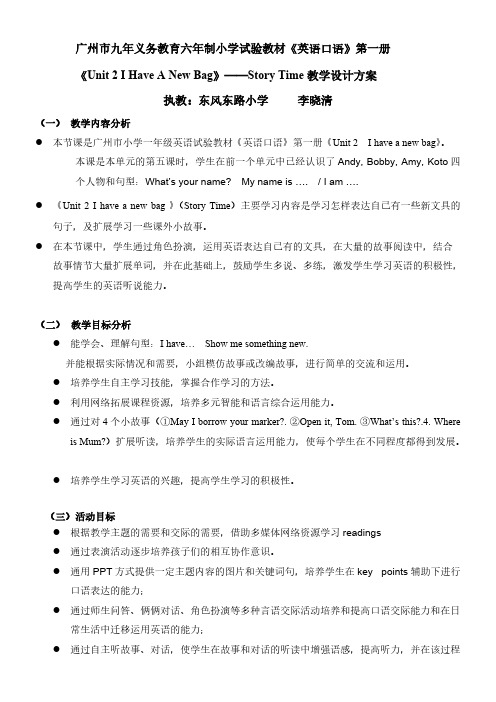
广州市九年义务教育六年制小学试验教材《英语口语》第一册《Unit 2 I Have A New Bag》——Story Time教学设计方案执教:东风东路小学李晓清(一)教学内容分析●本节课是广州市小学一年级英语试验教材《英语口语》第一册《Unit 2 I have a new bag》。
本课是本单元的第五课时,学生在前一个单元中已经认识了Andy, Bobby, Amy, Koto四个人物和句型:What’s your name? My name is …. / I am ….●《Unit 2 I have a new bag 》(Story Time)主要学习内容是学习怎样表达自己有一些新文具的句子,及扩展学习一些课外小故事。
●在本节课中,学生通过角色扮演,运用英语表达自己有的文具,在大量的故事阅读中,结合故事情节大量扩展单词,并在此基础上,鼓励学生多说、多练,激发学生学习英语的积极性,提高学生的英语听说能力。
(二)教学目标分析●能学会、理解句型:I have… Show me something new.并能根据实际情况和需要,小组模仿故事或改编故事,进行简单的交流和运用。
●培养学生自主学习技能,掌握合作学习的方法。
●利用网络拓展课程资源,培养多元智能和语言综合运用能力。
●通过对4个小故事(①May I borrow your marker?. ②Open it, Tom. ③What’s this?.4. Whereis Mum?)扩展听读,培养学生的实际语言运用能力,使每个学生在不同程度都得到发展。
●培养学生学习英语的兴趣,提高学生学习的积极性。
(三)活动目标●根据教学主题的需要和交际的需要,借助多媒体网络资源学习readings●通过表演活动逐步培养孩子们的相互协作意识。
●通用PPT方式提供一定主题内容的图片和关键词句,培养学生在key points辅助下进行口语表达的能力;●通过师生问答、俩俩对话、角色扮演等多种言语交际活动培养和提高口语交际能力和在日常生活中迁移运用英语的能力;●通过自主听故事、对话,使学生在故事和对话的听读中增强语感,提高听力,并在该过程中逐步培养和提高运用现代信息技术辅助学习的意识和能力。
广州版英语口语第一册Unit1 第三节《Listen and say》一课一练
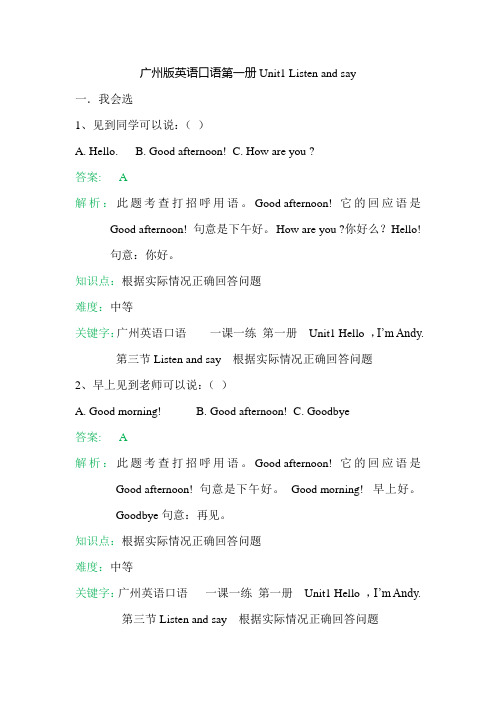
广州版英语口语第一册Unit1 Listen and say一.我会选1、见到同学可以说:()A. Hello.B. Good afternoon!C. How are you ?答案: A解析:此题考查打招呼用语。
Good afternoon! 它的回应语是Good afternoon! 句意是下午好。
How are you ?你好么?Hello!句意:你好。
知识点:根据实际情况正确回答问题难度:中等关键字:广州英语口语一课一练第一册Unit1 Hello ,I’m Andy.第三节Listen and say 根据实际情况正确回答问题2、早上见到老师可以说:()A. Good morning!B. Good afternoon!C. Goodbye答案: A解析:此题考查打招呼用语。
Good afternoon! 它的回应语是Good afternoon! 句意是下午好。
Good morning! 早上好。
Goodbye句意:再见。
知识点:根据实际情况正确回答问题难度:中等关键字:广州英语口语一课一练第一册Unit1 Hello ,I’m Andy.第三节Listen and say 根据实际情况正确回答问题3.在教室,老师上课叫到你的名字时,你可以回答()A. Good morning!B. Good afternoon!C. Here ,Miss Gao.答案: C解析:此题考查打招呼用语。
Good afternoon! 它的回应语是Good afternoon! 句意是下午好。
Good morning! 早上好。
Here ,Miss Gao.高老师,我在这。
知识点:根据实际情况正确回答问题难度:中等关键字:广州英语口语一课一练第一册Unit1 Hello ,I’m Andy.第三节Listen and say 根据实际情况正确回答问题4、向别人作自我介绍时说:()A. I’m Sarah.B. Hello!C. Goodbye!答案:A解析:此题考察自我介绍时的习惯用语。
2024年【广州版】六年级英语上册Unit1Whatarethosefarmersdoing1
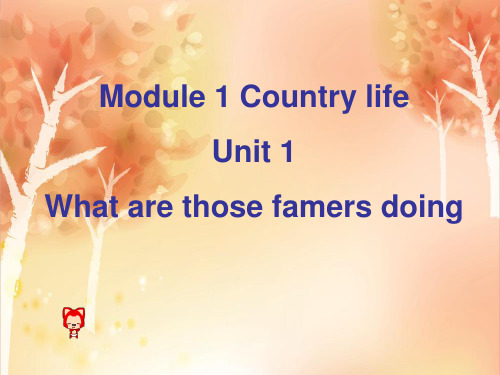
绩 ,
八
分
方
法
。
愿
全
天
下
所
有
父
母
我们,还在路上……
Module 1 Country life Unit 1
What are those famers doing
feed chickens
feed ducks
feed pigs
feed horses
grow flowers
grow vegetables
plant trees
What do you grow on your farm?
animals.
What does this animal eat ? What can it give us?
It eatg_r_a_s_s_and give us _m_i_lk__a_n_d__. meat
What does this animal eat ? What can it give us?
It eatv_e_g_e_t_a_b_le_s_and give us __m_e_a_t__.
What does this animal eat ? What can it give us?
It eat _w__o_rm__s__and give us e_g_g__s_.
What have we learnt in this class?
So many things. There are fruit trees in the field.
You can pick up apples if you want.
And in the field we grow rice.
What are those farmers doing?
广州市九年义务教育六年制小学试验教材《英语口语》第一册

广州市九年义务教育六年制小学试验教材《英语口语》第一册《Unit 2 I Have A New Bag》——Story Time教学设计方案执教:东风东路小学李晓清(一)教学内容分析●本节课是广州市小学一年级英语试验教材《英语口语》第一册《Unit 2 I have a new bag》。
本课是本单元的第五课时,学生在前一个单元中已经认识了Andy, Bobby, Amy, Koto四个人物和句型:What’s your name? My name is …. / I am ….●《Unit 2 I have a new bag 》(Story Time)主要学习内容是学习怎样表达自己有一些新文具的句子,及扩展学习一些课外小故事。
●在本节课中,学生通过角色扮演,运用英语表达自己有的文具,在大量的故事阅读中,结合故事情节大量扩展单词,并在此基础上,鼓励学生多说、多练,激发学生学习英语的积极性,提高学生的英语听说能力。
(二)教学目标分析●能学会、理解句型:I have…Show me something new.并能根据实际情况和需要,小组模仿故事或改编故事,进行简单的交流和运用。
●培养学生自主学习技能,掌握合作学习的方法。
●利用网络拓展课程资源,培养多元智能和语言综合运用能力。
●通过对4个小故事(①May I borrow your marker?. ②Open it, Tom. ③What’s this?.4. Where isMum?)扩展听读,培养学生的实际语言运用能力,使每个学生在不同程度都得到发展。
●培养学生学习英语的兴趣,提高学生学习的积极性。
(三)活动目标●根据教学主题的需要和交际的需要,借助多媒体网络资源学习readings●通过表演活动逐步培养孩子们的相互协作意识。
●通用PPT方式提供一定主题内容的图片和关键词句,培养学生在key points辅助下进行口语表达的能力;●通过师生问答、俩俩对话、角色扮演等多种言语交际活动培养和提高口语交际能力和在日常生活中迁移运用英语的能力;●通过自主听故事、对话,使学生在故事和对话的听读中增强语感,提高听力,并在该过程中逐步培养和提高运用现代信息技术辅助学习的意识和能力。
广州版第一册英语口语教案
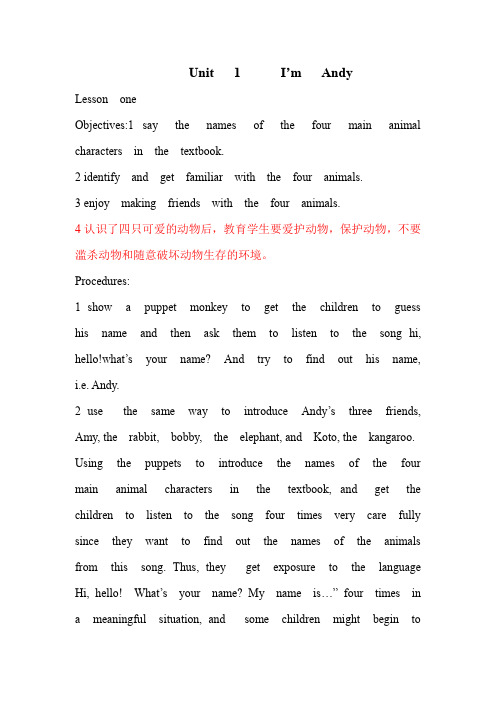
Unit 1 I’m AndyLesson oneObjectives:1 say the names of the four main animal characters in the textbook.2 identify and get familiar with the four animals.3 enjoy making friends with the four animals.4认识了四只可爱的动物后,教育学生要爱护动物,保护动物,不要滥杀动物和随意破坏动物生存的环境。
Procedures:1 show a puppet monkey to get the children to guess his name and then ask them to listen to the song hi, hello!what’s your name? And try to find out his name,i.e. Andy.2 use the same way to introduce Andy’s three friends, Amy, the rabbit, bobby, the elephant, and Koto, the kangaroo. Using the puppets to introduce the names of the four main animal characters in the textbook, and get the children to listen to the song four times very care fully since they want to find out the names of the animals from this song. Thus, they get exposure to the language Hi, hello! What’s your name? My name is…”four times in a meaningful situation, and some children might begin topick up these sentences.Activity 2 : look for the animals!1 Describe the picture:the four animals hide in the forest,and their teacher, Mr.leo, is looking for them.2 ask the children to point them out when hearing their names from the tape.Activity 3 : play a memory game1 put the pictures of Andy, Amy, Bobby and Koto on the blackboard and number them 1,2,3,4,under the pictures.2 the teacher says the numbers and asks the children to say the corresponding names. After the children have got familiar with these names,the teacher takes the pictures away and changes the order of the numbers(e.g. 3, 1, 4, 2.) And asks the children to guess the names from their memories.Activity 4: who am I ?1 ask the children to put the fragmentary pictures into the whole pictures of the four animals.2 say their names as soon as they finish piecing them together.activity 5 let’s singLesson twoObjectives: by the end of this lesson, hopefully the children will be able to:1 enjoy getting an English name.2 say their own English names.3 ask and answer about names in English .Procedures:Activity 1 : let’s singUse the puppets to sing the song hi hello!what’s your name? Again.Activity 2: who is talking to whom?1In this activity , the four animals are greeting each other . ask the children to match who is talking to whom.2Check the answers.Activity 3 : let’s choose english names~!1 the teache holds up a flash card with an english name on it and reads the english name, for example,julia!julia!2 all the girls who like this name can raise their hands and learn to say here! After the teacher. Then, the girl who can say the name the most accurately and beautifullywill get the flash card with this english name.3 the teacher tears down a sticker pictures representing the symbol of the name, julia, to the girl as a prize.4 the girl can stick the symbol beside julia and write down her chinese name beside he symbol on the appendix, names: write your name and your friends’names.”At the end of the students’book one. Other children also write down the girl’s chinese name on the appendix.5 the teacher uses this choose and stick game to give each child an english name.Activity 4 :play a listen and respond game1 the teacher puts up a mask of Mr. Leo and assigns masks of Amy, Andy, koto and bobby to four children. Then the teacher calls bobby! Bobby! And the child with the mask of bobby stands up quickly and answers, I’m here, Mr.Leo.2 the teacher plays the same”listen and respond”game with other three animal characters, and then explains how to use Mr.and Miss to call a male teacher or a female teacher.3 after several times of listening and practice of saying I am here, the teacher breaks the class into two teams,team A and team B. each team has got the children with or without english names.4 a child of team A without an English name points toa child of team B and calls “Liu Chao!”the child of team B needs to stand up at once and answers quickly, “here.”5 then , vice versa, it’s team B’s turn to challenge teamA.Lesson threeObjectives: by the end of this lesson, hopefully the children will be able to :1 say and remember other classmate’s English names.2 use English to ask and answer about English names.3 enjoy getting to know each other’s names.ProceduresActivity 1 : listen and tell the names they hear are the chinese names or the english ones.2 check the answers.Activity2 : listen and respondThe teacher calls the english names of those children who have got them in the last lesson one by one, and those children need to give a quick response. The teachercan encourage them to answer with the chunks”here,Mr./Mrs. Or “ yes, Mr./Mrs.”Activity 3 :self-introductions.1 the teacher uses the target language to do a demonstration of self-introduction first.2 get the children to sit in a circle in different groups and introduce their chinese and english names in english one by one.Lesson 4Objectives: by the end of this lesson, hopefully the children will be able to:1 follow the teacher’s instructions and make their own name tags;2 enjoy making the name tags.3 introduce their own english names using the newly-made name tags;4 enjoy singing the chant to greet each other.ProceduresActivity1 : let’s make name tags!1 get the children to follow the teacher’s instructions andmake their own name tags.2 the teacher goes around the classroom and gives comments like super!great!good!ok!Activity 2 : look at my beautiful name tags!1 the teacher first gets a few children to show their name tags encouraging them to say hello,my name is...2 the teacher gives comments like super! Great! Good ! ok! As they show their newly-made name tags.3 ask the children to share their name tags in groups using the target language.Activity 3 : let’s chant a rhyme!1 identify the four big groups of children as super group, good group, ok group and great group respectively.2 ask each group to shout their own slogans one by one as soon as the whole class finishes singing “how are you.”3 swap identities so that all four groups have the chance to say other words.4 when the children get skilful, the teacher can replace the names in the chant with the children’s english names.5 ask them to give group performances.Activity 4 what are they saying?1 in this activity, the children need to work in groups and design mini dialogues for the two children in the picture.2 act out the dialogues.Lesson fiveObjectives:1 greet and treat each other politely.2 understand and retell the adapted story with the help of the teacher.3 dramatise a similar little story and learn a lesson from the story.4 enjoy the story5 do a simple self-assessment of their performance in this unit.ProceduresActivity 1 : tell a storyTell a story with the help of pictures or realia to the children . in order to make the plot of this story more interesting, a suggested ending is added to give some spice and some educational value to the story , i.e. be nice to each other. The alternative story goes like this.Activity 2 : retell the storyThe children try to retell the story with the help ofthe teacher and the realia.Activity 3 dramatize the story1 give enough time for the children to dramatize the story in groups.2 give chances for them to act out. They can use their own names to replace the original characters and design their own stories.Activity 4 : I’m super in english1 ask the children to do a simple self-assessing activity.2 comment on their performance in this unit positively.教学后记:学生首次接触英语,大家都很有兴趣。
口语教材分析

广州市小学一年级《英语口语》第一册教材分析我分析的是广州市小学一年级《英语口语》第一册教材分析第一册,目录如下:Lesson 1 :HELLO,I’M ANDYLesson 2 :I HAVE A NEW BAGLesson 3 :COUNT FROM ONE TO TENLesson 4 :I LIKE GREENLesson 5 :I CAN JUMPLesson 6 :HERE’S MY SCOOTER本套教材共分6单元。
开学初,大家都不认识对方,情景较为真实而自然,孩子们都渴望知道其他小朋友的姓名或告诉别人他们的名字,这样能激发他们的交流欲望。
学习句型Hi/hello.What’s your name? My name is …第1课时先教LET’S SING,让孩子们感受英语的快乐,歌曲简单,容易上口,孩子们很快就把问候用语和询问别人的姓名记住了。
接着第 2 个课时教LET’TRY,这部分跟歌曲的内容联系紧密,孩子们用英语告诉别人自己的名字。
当老师和孩子们对班里面的小朋友的名字有点印象后,就来个点名,让他们在第3 课时学习LETS PLAY。
至于LET’S MAKE 这一部分,我认为可以删掉,因为孩子们刚学英语,甚至有部分学生还不会用中文写名字。
第4课时可以教ANDY’S BOX, 这节课主要是检测和巩固孩子们之前所学的知识,可以用here and now 方法和使用金太阳软件。
第 5 个课时认识五个动物的名字及其特征。
最后是STORY TIME. 建议用边听边猜,边听边说,或者听后又向自己的伙伴转述的方法学这个故事,《金太阳软件》中这个故事的动画做得很好,孩子们都非常爱看。
第2单元,同级的语文、数学教材都有关于数字1---10的学习,都安排在较先的位置,把Unit3 提前学习,通过同步教学,这样更能激发孩子们的认识数字的愿望,他们更能理解并记住1—10的数字。
学习句型How many…?第 1 课时先用形式多样的方法教会孩子们的英语数字1—10,因为书本上安排在第一部分的歌曲中的新单词教多,不适宜先教。
英语口语第一册UNIT6第四课时STORYTIME编写人蒋恒和番禺区市桥中心小学
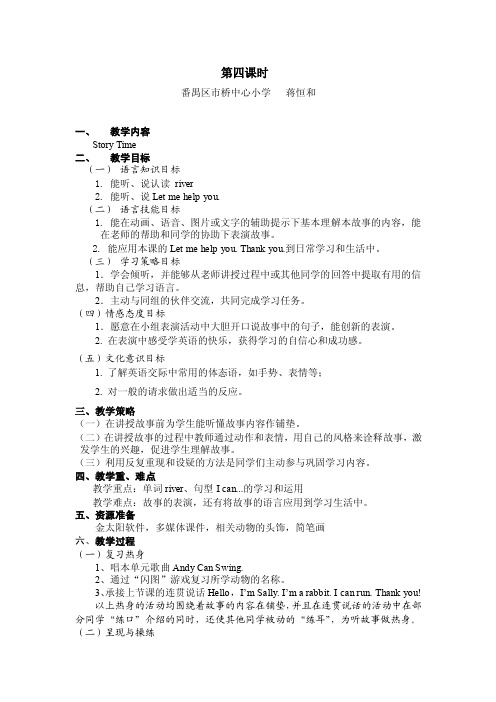
第四课时番禺区市桥中心小学蒋恒和一、教学内容Story Time二、教学目标(一)语言知识目标1. 能听、说认读river2. 能听、说Let me help you.(二)语言技能目标1. 能在动画、语音、图片或文字的辅助提示下基本理解本故事的内容,能在老师的帮助和同学的协助下表演故事。
2.能应用本课的Let me help you. Thank you.到日常学习和生活中。
(三)学习策略目标1.学会倾听,并能够从老师讲授过程中或其他同学的回答中提取有用的信息,帮助自己学习语言。
2.主动与同组的伙伴交流,共同完成学习任务。
(四)情感态度目标1.愿意在小组表演活动中大胆开口说故事中的句子,能创新的表演。
2. 在表演中感受学英语的快乐,获得学习的自信心和成功感。
(五)文化意识目标1. 了解英语交际中常用的体态语,如手势、表情等;2. 对一般的请求做出适当的反应。
三、教学策略(一)在讲授故事前为学生能听懂故事内容作铺垫。
(二)在讲授故事的过程中教师通过动作和表情,用自己的风格来诠释故事,激发学生的兴趣,促进学生理解故事。
(三)利用反复重现和设疑的方法是同学们主动参与巩固学习内容。
四、教学重、难点教学重点:单词river、句型I can...的学习和运用教学难点:故事的表演,还有将故事的语言应用到学习生活中。
五、资源准备金太阳软件,多媒体课件,相关动物的头饰,简笔画六、教学过程(一)复习热身1、唱本单元歌曲Andy Can Swing.2、通过“闪图”游戏复习所学动物的名称。
3、承接上节课的连贯说话Hello,I’m Sally. I’m a rabbit. I can run. Thank you!以上热身的活动均围绕着故事的内容在铺垫,并且在连贯说话的活动中在部分同学“练口”介绍的同时,还使其他同学被动的“练耳”,为听故事做热身。
(二)呈现与操练1. 教师讲故事。
(1)师(总结刚刚进行完的连贯说话活动):你们的本领还挺大的,那接下来同学们听听老师的故事中谁的本事最大、最热心。
广州小学英语口语第一册Unit 1 Hello, I'm Andy教学设计
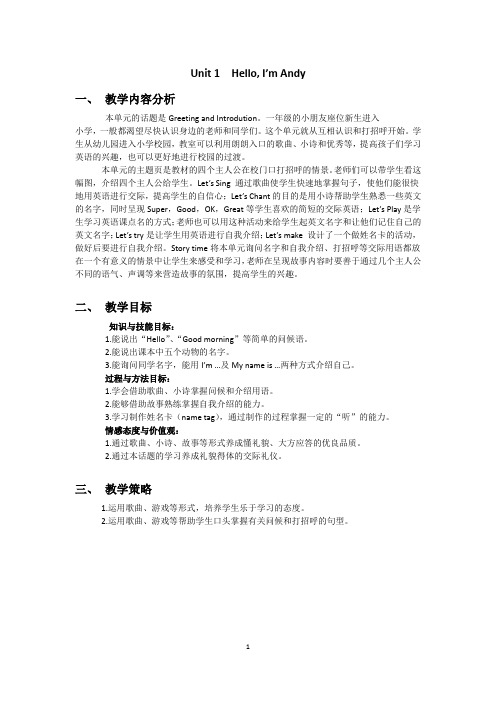
Unit 1 Hello, I’m Andy一、教学内容分析本单元的话题是Greeting and Introdution。
一年级的小朋友座位新生进入小学,一般都渴望尽快认识身边的老师和同学们。
这个单元就从互相认识和打招呼开始。
学生从幼儿园进入小学校园,教室可以利用朗朗入口的歌曲、小诗和优秀等,提高孩子们学习英语的兴趣,也可以更好地进行校园的过渡。
本单元的主题页是教材的四个主人公在校门口打招呼的情景。
老师们可以带学生看这幅图,介绍四个主人公给学生。
Let’s Sing 通过歌曲使学生快速地掌握句子,使他们能很快地用英语进行交际,提高学生的自信心;Let’s Chant的目的是用小诗帮助学生熟悉一些英文的名字,同时呈现Super,Good,OK,Great等学生喜欢的简短的交际英语;Let’s Play是学生学习英语课点名的方式;老师也可以用这种活动来给学生起英文名字和让他们记住自己的英文名字;Let’s try是让学生用英语进行自我介绍;Let’s make 设计了一个做姓名卡的活动,做好后要进行自我介绍。
Story time将本单元询问名字和自我介绍、打招呼等交际用语都放在一个有意义的情景中让学生来感受和学习,老师在呈现故事内容时要善于通过几个主人公不同的语气、声调等来营造故事的氛围,提高学生的兴趣。
二、教学目标知识与技能目标:1.能说出“Hello”、“Good morning”等简单的问候语。
2.能说出课本中五个动物的名字。
3.能询问同学名字,能用I’m …及My name is …两种方式介绍自己。
过程与方法目标:1.学会借助歌曲、小诗掌握问候和介绍用语。
2.能够借助故事熟练掌握自我介绍的能力。
3.学习制作姓名卡(name tag),通过制作的过程掌握一定的“听”的能力。
情感态度与价值观:1.通过歌曲、小诗、故事等形式养成懂礼貌、大方应答的优良品质。
2.通过本话题的学习养成礼貌得体的交际礼仪。
广州版小学《英语口语》第一册教材分析

广州版小学《英语口语》第一册教材分析一、总体描述:(一)、指导思想:广州版小学《英语口语》教材“将小学一、二年级的英语课程作为一门基础性、启蒙性课程,以激发儿童对英语学习的兴趣,促进儿童的身心健康、和谐地发展为目标,注意与其他学科最简单易学、最有趣味、最基础的知识之间的相互融合。
他以与儿童的体验和各种各样的活动作为课程组织的主要线索和主要的学习方式,使学生在生动活泼、多样有趣的活动中产生对英语学习的兴趣,获得身心的发展。
”教材在编写内容的选择上将更多地考虑与高年级教材的衔接、铺路。
争取减轻高年级的负担。
衔接一个重要的方面就是同一主题的重复和螺旋式上升。
(二)、教材结构:Success with English 《英语口语》第一册是供小学一年级新生第一学期使用的,教材除课本外还有活动手册、教师教学用书、教学图片、VCD等供教师或学生使用的配套材料。
第一册在容量上是6个单元和两个复习部分,每个单元是由let’s sing/let’s chant/let’s try/let’s make/let’s play/story time六个版块组成,这几个版块的顺序更多的是为了保证教材体例上的统一性,教师们在教学中完全可以、甚至必须调整顺序。
(三)、教学语言编写特点:1、尽量口语化。
主要是考虑到部分学生可能上不了口的句子。
e.g. A: How many dogs? B: Four. 而不是A: How many dogs are there? B: There are four.2、保证重点句型在有意义的情景中重复。
如Story Time 部分,不仅是句型相同,句子的大部分成分也相同。
E.g. I like the balloons! I like green. I like pink. I like purple. I like yellow. I like yellow too.(四)、各板块的教学要求和教学建议:二、分类目标描述:(一)、语言学习技能的培养:一年级的学生刚步入校园,对英语学科是充满好奇和渴望的,但结合学生自身的实际情况,语言学习技能目标主要以学生“能做什么”为主要内容,这不仅有利于调动学生的学习积极性,促进学生语言运用能力和学习兴趣的提高,也有利于科学合理地评价孩子的学习结果。
义务教育教科书英语六年级上册Module1Country
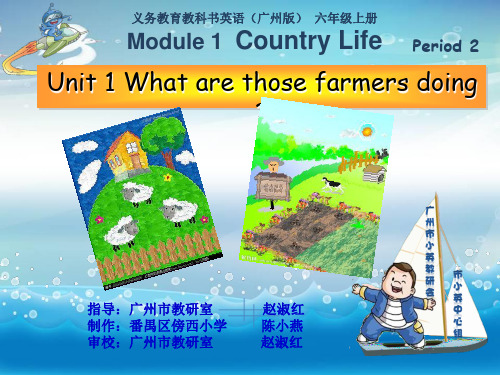
Let’s talk.
A: What is the farmer growing in this field ? B: ______________. You can pick some ____ if ____.
beside
提示:要求学生完整回答,如 Beside the desk.
Let’s play.
Where is the mouse ?
on
Let’s play.
Where is the mouse ?
in
Let’s play.
Where is the mouse ?
under
Let’s play.
游戏规则:请一位学生站在讲台旁边,背对屏 幕问:Where is the mouse ?台下的学生要按 照ppt说出老鼠的位置。站在讲台旁的学生听 到后要根据其位置拍打讲台,如听到on the desk就要拍讲台的台面。(可以准备一个苍蝇 拍避免拍痛手)
Let’s play.
Where is the mouse ?
Where is the mouse ?
in front of
Let’s play.
Where is the mouse ?
behind
Let’s play.
Where is the mouse ?
Let’s play.
Where is the mouse ?
提示:教师可以根据需要增加练习的次数和速度,学生能熟练说出方位介词即可。
《义务教育课程标准实验教科书 英语 ( 新版 ) 》

《义务教育课程标准实验教科书英语 ( 新版 ) 》第 1 一 3 册总体介绍《义务教育课程标准实验教科书英语 ( 新版 ) 》 (New Primary English for China) 是人民教育出版社与新加坡泛太平洋出版有限公司合作在原教材《小学英语》 (Primary English for China) 基础上,依据国家《英语课程标准》重新编写的一套小学英语教材。
本套教材供小学 3 ~ 6 年级的学生使用,难易程度适合全国大部分地区的学校。
全套教材共八册,每学期一册,学习四年。
小学毕业后直接与《新版初中英语》 (New Junior English for China) 相衔接。
一、教材编写背景九年义务教育小学教科书《小学英语》 (Primary English for China) 是人民教育出版社于 1991 年至 1994 年与新加泛太平洋出版有限公司合作编写的一套小学英语教材。
这教材供小学 4 —5 年级 ( 五年制 ) 和 5 —6 年级 ( 六年制 ) 生使用。
全套教材共四册,每学期一册,学习两年。
这套材已于 1993 年 9 月开始,先后在辽宁、吉林、黑龙江、苏、浙江、安徽、山西、山东、河南、湖南、湖北、四川、重庆、江西、广东等地区的小学进行实验。
经过近十年的验,这套教材得到了全国数百万小学英语教师、学生和家的好评。
为了贯彻落实教育部新颁布的《英语课程标准》和《小学英语课程教学基求》,以更好地适应当前我国从小学三年级开设英语课师资、教学条件的实际情况,真正满足广大小学英语教师、学生和家长的需要,全面提高我国小学英语教育教学质量,人民教育出版社与新加坡泛太平洋出版有限公司再次合作将《小学英语》 (Primary English for China) 改编成《新版小学英语》 (New Primary English for China).二、教材编写思路《义务教育课程标准实验教科书英语 ( 新版 ) 》的设计与编写,以“继承一发展一创新”为宗旨,充分吸收了原教材在近十年的试用过程中积累的丰富经验,又分析和研究了国内外的多种小学英语教材,取其精华,博采众长,形成了一套适合我国当前小学英语教育基本状况和小学英语教学实际需要的新教材。
广州小学英语口语第一册Unit 4 I Like Green教案

Unit 4 I Like Green一、教学内容分析本单元的话题是颜色。
主要学习内容是八个颜色单词以及谈论自己喜欢的颜色的用语。
学生对颜色这个主题的学习兴趣比较浓,对有关知识的接受速度会比较快。
由于本模块的话题是学生非常熟悉而且和生活息息相关的,因此教室应多从学生的身边找素材,帮助学生建立学习内容与生活的联系。
从各个栏目的内容来看,Let’s Sing 通过一首小诗呈现了6个颜色单词;Let’s Chant 呈现了两个新的颜色单词及I like…这个句型。
Let’s Move通过TRP的游戏活动来巩固所学的颜色;Let’s Try则通过一个中找相同颜色的单词卡的活动进一步巩固所学的颜色,并引导学生认读单词;Let’s Make是一个做彩虹的手工活动,这个活动与前面的歌曲联系起来,达到手工活动与语言活动的统一;Story Time将本单元的语言知识放在有意义的情景中让学生体验和感受。
二、教学目标知识与技能目标:1.二会颜色词汇:green, orange, pink, black, red, yellow, blue, purple2.二会掌握句型:What colour is it? It’s…I like…3.掌握日常用语:It’s cool. I’m OK.过程与方法目标:1.能表演本单元歌曲、诗歌和故事。
2.能正确地辨听和说出英文的颜色单词,并运用到实际生活中。
3.能够与人谈论自己喜欢的颜色。
4.能简单描述物体颜色,如a pink bag, a yellow book, The bag is pink 等。
情感态度值观:让学生在做、玩、角色扮演中学习新内容,感受如何简单地把所学的知识运用到日常生活中,能在英语游戏、故事中感受英语学习的乐趣。
三、教学策略颜色在生活中是无处不在的,因此,在教学中可以充分利用学生身边的实物来进行颜色的教学。
另外,颜色还可以与前面单元中学习的文具、玩具等结合起来学习,达到温故知新的母的。
广州版六年级英语上册课本
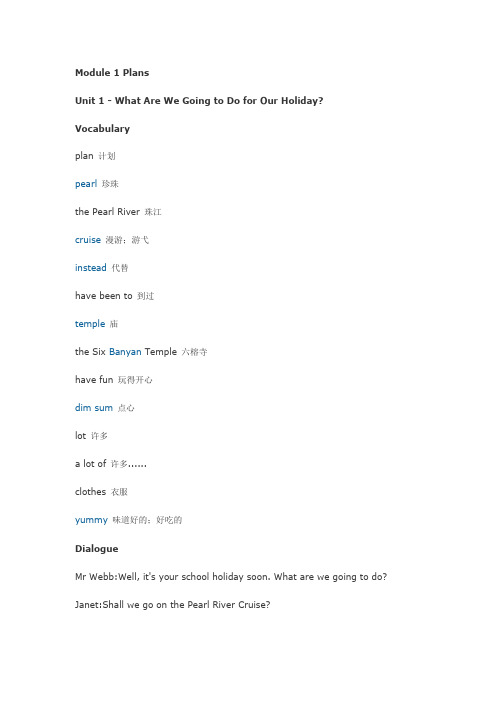
Module 1 PlansUnit 1 - What Are We Going to Do for Our Holiday?Vocabularyplan 计划pearl珍珠the Pearl River 珠江cruise漫游;游弋instead代替have been to 到过temple庙the Six Banyan Temple 六榕寺have fun 玩得开心dim sum点心lot 许多a lot of 许多......clothes 衣服yummy味道好的;好吃的DialogueMr Webb:Well, it's your school holiday soon. What are we going to do? Janet:Shall we go on the Pearl River Cruise?Ben:A cruise? Boring! Let's go to Xiangjiang Zoo instead! I'm going to see white tigers.Janet:Oh no. We have been to the zoos in Guangzhou many times. We're going to the Six Banyan Temple. We're going to take photos, and all of us are going to have fun there.Ben:It's boring too.Mr Webb:Let's go to Baiyun Hill. We are going to watch birds there.Janet:We can see more birds at the zoo than on Baiyun Hill.Mrs Webb:Shall we go shopping in Xiajiu Road? Then we can have dim sum at the famous Guangzhou Restaurant.Janet:Good idea! I want to buy some new clothes. There are a lot of beautiful clothes there.Ben:Great! I like Guangdong dim sum. Yummy, yummyUnit 2 What Shall We Do?go fishing 去钓鱼love 爱stupid愚蠢的on 上演tonight今晚;在今晚king国王DialogueJanet:What are you going to do on Thursday morning, Xiaoling?Xiaoling:Mmm...let me see. I'm not going to do anything. Why?Janet:My family are going fishing. Would you like to go with us?Xiaoling:I'd love to, thanks a lot. When are you going to start?Janet:We are going to leave our house at half past eight. Why don't you come to our house at twenty past eight?Xiaoling:Great! I'll see you then!Jiamin:Are you going to watch the footfall game on TV tomorrow evening, Ben?Ben:Yes, we are. I'm going to watch it together with Mike and Yongxian.Jiamin:My family are watching a stupid film when the football game is on. So I can't watch it.Ben:Why don't you come to my house to watch it? We're going to have dinner before the game. You can eat with us too.Jiamin:Thanks. Ben. I'll ask my parents.Xiaolin:Janet, do you want to play table tennis with me tonight?Janet:I'm sorry, I can't. I'm going to do my homework.Xiaoling:What about tomorrow night?Janet:I'm sorry, I can't. I'm going swimming with my parents.Xiaoling:What about Saturday night?Janet:To tell you the truth, I don't like playing table tennis. I'm going to the cinema with Ben tonight!Sally:What film are you going to see?Janet:The Lion King.Sally:Can I go with you?Janet:Yes, of course. But you'd better ask your parents first.Unit Four - I Know This City!flag 旗national国家的;民族的national flag 国旗capital首都Italian 意大利的;意大利语;意大利人Italy 意大利Rome 罗马Paris 巴黎America 美国;美洲Washington D.C. 华盛顿哥伦比亚区New York 纽约excellent极好的;优秀Tokyo 东京Wellington 惠灵顿Sydney 悉尼Canberra 堪培拉DialogueLook and listen. Then read and act in groups.Mr Chen: Boys and girls, look at this flag please. What national flag is it? Ben: Easy! It's the Chinese national flag.Mr Chen: Good. What's the capital of China?Ben: That's easy too. The capital of China is Beijing.Mr Chen: Very good. Look at these three flags. What national flags are they? Janet: That's the national flag of the UK. The capital of the UK is London. Xiaoling: That is the Italian national flag.Mr Chen: What's the capital city of Italy, do you know?Yongxian: I know, Mr Chen. It's Rome.Janet: And that's the French national flag. The capital of France is Paris.Mr Chen: Excellent! What about this one?Jiamin: That's the American national flag. New York is the capital of America.Sally: No. The capital of the USA is Washington D.C.. New York is the biggest city of the USA.Mr Chen: Fantastic! Look at this flag. What flag is it, Janet?Janet: It's the national flag of Australia?Mr Chen: What's the capital of Australia?Janet: Sydney.Mr Chen: No. Sydney is the largest city of Australia. The capital of Australia is Canberra.Unit 5 Where Would They Like to Go On Holiday?maybe 可能noisy 吵闹的crowded拥挤的quiet 安静的just 仅仅;正;恰好;刚Moscow 莫斯科Russia 俄罗斯Berlin 柏林the Great Wall 长城mountain山;山脉population人口million百万DialogueMr Webb:Children, where would you llike to go on holiday this summer? Ben:I'd like to go to Japan.Mrs Webb:Tokyo. Yes, Tokyo is a good place to visit.Janet:Yes, Mum. But Paris is more beautiful than Tokyo.Mrs Webb:Well, maybe, Janet. But I think Tokyo is more interesting than Paris.Mr Webb:Well, I'd like go to a warmer place. What about Rome? Rome is warmer than Paris.Nrs Webb:Yes, but Tokyo, Paris and Rome are so noisy and crowded. What about Wellington?Ben:Wellington? That's the capital of New Zealand.Mrs Webb:Yes. Wellington is quieter than the other cities. I'd like to go to Wellington.Ben:But Wellington is boring!Mr Webb:No, it's not. The mountains and the sea are beautiful.Mrs Webb:And Willington is cleaner than Tokyo.Ben:Maybe. But I prefer to go to Tokyo.Mrs Webb:There are so many beautiful places in the world! Where shall we go?Janet:Well, I'd like to go to Paris.Ben:I'd like to go to Tokyo.Mr Webb:I'd like to go to Rome.Mrs Wedd:I'd like to go to Wellington.Janet:Why don't we go back to England?Ben:Let's just visit Beijing. We can visit the Great Wall!All:That's a good idea!Unit Seven - Ben Wants to Play Footballbored厌烦的away 离开go away 走开later以后won't=will not 将不poor可怜的match比赛circus马戏团go boating 去划船go swimming 去游泳come to tea 来喝茶DialogueMr Webb:What's the matter, Ben? You don't look happy.Ben:I'm bored! Dad, do you want to play football?Mr Webb:We can't! It's raining.We'll get wet.Ben:Oh, dad! Janet, shall we go to see the film The Lion King? It's really good. Janet:No, I'm watching TV.Ben:But I'm bored. Would you like to go to the cinema with me?Janet:Well, maybe later.Ben:Oh, Mum, I'm so bored. It's raining and dad won't play football with me. Mrs Webb:And what about Janet?Ben:She's watching TV.Mrs Webb:Poor Ben.Mrs Webb:I'm going shopping now. Ben, do you want to go with me?Ben:Er… no, thanks, Mum.Mrs Webb:Are you sure? We could buy hamburgers for lunch.Ben:But Mum, I don't like shopping! It's so boring!Ben:Hi, Mike, what are you doing?Mike:Hi, Ben. I'm doing nothing. I'm really bored. Would you like to come to my house? We could play computer games.Ben:Great! Dad, can I go to Mike's house?Mr Webb:Of course you can!Unit 8 - Janet Is Going to Have a PartyVocabularyinvite邀请picnic野餐outside外面,在外面bring 带来CD 激光唱片VCD 可视激光光盘problem问题DialogueJanet:Mum.Mrs Webb:Yes, Janet?Janet:It's my brithday soon.Mrs Webb:Yes, it is. What would you like to do? Would you like to have a party?Janet:Oh, yes, please, Mum! A big party! Can we invite all my friends? And all the people in my class? And my teacher too?Mrs Webb:Well, maybe. Let's ask your father.Mr Webb:That's a lot of people! Our house is too small!Janet:Oh please! I want them all to come!Mrs Webb:Well, maybe we could have a picnic outside.Janet:Yes! Yes! A picnic would be great! Oh please, Dad!Mr Webb:OK then. But you have to help your mother, Janet.Janet:Oh yes, of course!Janet:It's my birthday next Saturday. I'm going to have a big party! Would you like to come?Sally:I'd love to. Shall I bring some food?Janet:No, it's OK. My Mum will make all the food. But you can bring some Coke. Sally:Right. What time is the party?Janet:It starts at one o'clock. See you then!Sally:See you.Ben:Janet, would you like to come and listen to my new CD?Janet:No, thanks, Ben. I don't like your CDs.Ben:Janet, do you want to play computer games with me? Janet:No, thanks, Ben. I'm reading!Ben:Janet…Janet:Oh, all right, Ben! Do you want to come to my party? Ben:Great! Can I bring a friend?Janet:Who?Ben:Billy, the alien.Janet:The alien? No problem!Unit 10 - May I speak to Miss White?Vocabularytelephone电话,打电话afraid恐怕,害怕message消息,消息take a message 传递消息were 是(are的过去式)weren't=were not 不是was 是(am, is的过去式)doll玩具娃娃free 有空的,自由的bookstore书店answer 回答busy 忙的DialogueMrs White:Hello. This is Mrs White speaking.Xiaoling:May I speak to Miss White?Mrs White:She's not here, I'm afraid.Xiaoling:When will she come back?Miss White:At lunch time, I think. Can I take a message for her?Xiaoling:No, thanks.Miss White:Hello.Xiaoling:Hello. Can I speak to Miss White?Miss White:Speaking. Who's that, please?Xiaoling:It's Xiaoling here.Miss White:Hello, Xiaoling. How are you?Xiaoling:Very well, thanks. And you?Miss White:I'm fine too. Thanks.Xiaoling:I called you this morning. But you weren't at home.Miss White:Sorry. I was at school this morning.Xiaoling:It's my brithday this Saturday. I'm having a big party at home. Would you like to come?Miss White:I'd love to. At what time is the party? Xiaoling:We'll start at one o'clock. See you this Saturday! Miss White:See you then.。
广州版小学英语第一册教材分析

广州版小学英语SUCCESS WITH ENGLISH 第一册教材分析Module 1 Greeting( Hello\good morning)知识与技能目标:1.能口头用英语从1数到3;2.能按字母表顺序说出、辨认、写出字母Aa-----Nn Aa---Zz;3.能用英语进行问候、打招呼;Hello\How are you?4.能用句子介绍人物;This is ….5.能用英语询问别人的名字和说出自己的名字;What your name? I’m….. My name is ……..为方便教学增加What is this ?\It is ….句子。
注意问题:1.激发学生说英语的兴趣,多使用英语问候语与学生交流;2.字母教学:发音、大小写字母的书写、形状辨认、同音素分类、元音字母和辅音字母的分类;教学中活动、游戏的设计。
3.Mr\Mrs \Miss Li称呼的使用4.字母的相近发音。
Module 2My body(wash my face\raise my arms)知识与技能目标:1.能用口头英语从1数到6;2.能按字母表顺序说出、辨认、写出字母Aa---Zz;3.能用英语说出、写出人体部分的名称;4.能英语指令作动作:wash your face\brush your hair等。
5.正确区分my –your left ----right注意问题:1.单词区分读音:head –hair-hand leg_left you-your2.ears\eyes\armsModule 3 stationery(Where is my pencil?Please lend me your ruler)知识与技能目标:1.能用口头英语从1数到9;2. 能用英语说出、写出文具单词;3.掌握运用句型:(1)My .. is on \in the …..(2)Where is the \ my \your…?-----It’s on\ in……(3)Is it ….?|Yes, it is> No, it isn’t.4.借物用语:Please lend me your…..Here you are. Here is my…..注意问题:1. 缩写词:I’m / isn’t / Where’s2. 区分:table—desk I ---meModule 4 Colour(Look at the rainbow\draw a picture)知识与技能目标:1.能用口头英语从1数到12;2. 能用英语说出、写出颜色单词;red \blue….3.掌握运用句型问答:(1)What’s that \this in English?-----It’s a /an……(2)Is your ….yellow?-----Yes, it is ./ No, it isn’t.4. 能听、发英语指令作反应:Colour it red. Draw a /an …5.学会使用提建议句子:Let’s注意问题:1.a/an /the的用法2.缩写let’s=let usModule 5Transport(It’s a spaceship\Is this a car?)知识与技能目标:1.能用口头英语从1数到15;2. 能用英语说出、写出交通工具的名称。
九年义务教育三年制初级中学教科书英语第一册

九年义务教育是指在我国实施的义务教育制度中,对适龄儿童和少年实行的义务教育有九年制的规定。
而初级中学教科书英语第一册则是九年义务教育中的一部分,它在教育体系中扮演着重要的角色。
接下来将从以下几个方面来介绍九年义务教育和初级中学教科书英语第一册。
1.九年义务教育的背景和意义九年义务教育的实施,是我国教育改革的一项重要政策。
其背景是为了让更多的儿童和少年接受到较为完整的初等教育,提高整个国家的文化素质和科学知识水平。
也是为了实现全面建设小康社会的战略目标,培养更多的高素质人才,推动经济社会的可持续发展。
九年义务教育的实施具有深远的意义,不仅对于个体的成长和发展有着重要的影响,也对国家的未来发展起着重要的推动作用。
2.初级中学教科书英语第一册的编写目的和重要性初级中学教科书英语第一册是九年义务教育中的重要教材之一。
它的编写目的主要是为了帮助学生打好英语学习基础,提高学生的英语听、说、读、写能力,使学生能够在日常生活和学习中灵活运用英语进行交流。
通过学习英语,也能够开拓学生的国际视野,增加对外国文化和历史的了解,促进学生的全面发展。
初级中学教科书英语第一册的编写具有重要的理论和实践意义,对于学生的英语学习和发展起着至关重要的作用。
3.初级中学教科书英语第一册的内容概述初级中学教科书英语第一册主要包括基本的英语语音、语法知识,以及日常交际用语和基本的阅读和写作技能。
其中,涵盖了多种日常生活场景和话题,如家庭、学校、朋友、节日等,同时也会引导学生对一些简单的英语文章进行阅读和理解,培养学生的阅读能力。
通过这些内容的学习,学生不仅能够掌握基本的英语知识和技能,而且能够在实际生活中进行简单的英语交流和表达。
4.初级中学教科书英语第一册的教学方法和特点在教学方法上,初级中学教科书英语第一册注重培养学生的英语实际运用能力,倡导以学生为中心的教学模式,注重启发式教学,激发学生学习的兴趣和主动性。
教科书中也设计了丰富多样的教学活动和练习题,以帮助学生巩固知识、提高能力。
广州市小学英语口语课本(上册)第27课教学设计_一年级英语教案_模板
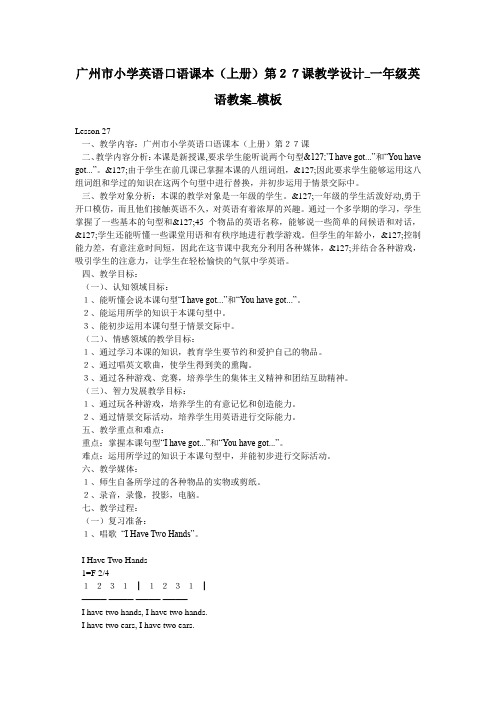
广州市小学英语口语课本(上册)第27课教学设计_一年级英语教案_模板Lesson 27一、教学内容:广州市小学英语口语课本(上册)第27课二、教学内容分析:本课是新授课,要求学生能听说两个句型&127;”I have got...”和“You have got...”。
&127;由于学生在前几课已掌握本课的八组词组,&127;因此要求学生能够运用这八组词组和学过的知识在这两个句型中进行替换,并初步运用于情景交际中。
三、教学对象分析:本课的教学对象是一年级的学生。
&127;一年级的学生活泼好动,勇于开口模仿,而且他们接触英语不久,对英语有着浓厚的兴趣。
通过一个多学期的学习,学生掌握了一些基本的句型和&127;45个物品的英语名称,能够说一些简单的问候语和对话,&127;学生还能听懂一些课堂用语和有秩序地进行教学游戏。
但学生的年龄小,&127;控制能力差,有意注意时间短,因此在这节课中我充分利用各种媒体,&127;并结合各种游戏,吸引学生的注意力,让学生在轻松愉快的气氛中学英语。
四、教学目标:(一)、认知领域目标:1、能听懂会说本课句型“I have got...”和“You have got...”。
2、能运用所学的知识于本课句型中。
3、能初步运用本课句型于情景交际中。
(二)、情感领域的教学目标:1、通过学习本课的知识,教育学生要节约和爱护自己的物品。
2、通过唱英文歌曲,使学生得到美的熏陶。
3、通过各种游戏、竞赛,培养学生的集体主义精神和团结互助精神。
(三)、智力发展教学目标:1、通过玩各种游戏,培养学生的有意记忆和创造能力。
2、通过情景交际活动,培养学生用英语进行交际能力。
五、教学重点和难点:重点:掌握本课句型“I have got...”和“You have got...”。
难点:运用所学过的知识于本课句型中,并能初步进行交际活动。
广州英语口语一年级上册 活动手册
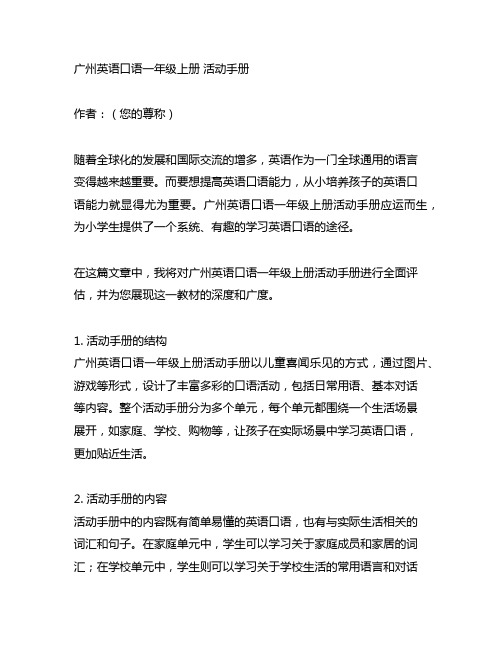
广州英语口语一年级上册活动手册作者:(您的尊称)随着全球化的发展和国际交流的增多,英语作为一门全球通用的语言变得越来越重要。
而要想提高英语口语能力,从小培养孩子的英语口语能力就显得尤为重要。
广州英语口语一年级上册活动手册应运而生,为小学生提供了一个系统、有趣的学习英语口语的途径。
在这篇文章中,我将对广州英语口语一年级上册活动手册进行全面评估,并为您展现这一教材的深度和广度。
1. 活动手册的结构广州英语口语一年级上册活动手册以儿童喜闻乐见的方式,通过图片、游戏等形式,设计了丰富多彩的口语活动,包括日常用语、基本对话等内容。
整个活动手册分为多个单元,每个单元都围绕一个生活场景展开,如家庭、学校、购物等,让孩子在实际场景中学习英语口语,更加贴近生活。
2. 活动手册的内容活动手册中的内容既有简单易懂的英语口语,也有与实际生活相关的词汇和句子。
在家庭单元中,学生可以学习关于家庭成员和家居的词汇;在学校单元中,学生则可以学习关于学校生活的常用语言和对话等。
这些内容贯穿了孩子们日常生活中的方方面面,让他们在学习中能够轻松、愉快地掌握英语口语。
3. 个人观点和理解我认为,广州英语口语一年级上册活动手册不仅仅是一本教材,更像是一本娱乐性强、教育性强的启蒙读物。
通过生动有趣的活动设计,孩子们可以在玩中学,潜移默化地掌握英语口语。
在学习的过程中,他们不仅能够提高英语口语能力,还能够增进对英语的兴趣,培养与国际接轨的意识。
总结回顾广州英语口语一年级上册活动手册以其深度和广度兼具的设计,为孩子们的英语口语学习提供了更广阔的空间。
通过丰富多彩的口语活动,让孩子在轻松愉快的氛围中学会运用英语口语。
个人认为,这种教材不仅仅是为了学习英语口语,更是为了培养孩子们的国际视野和跨文化交流能力。
在知识的文章格式中,我会将以上内容转化成序号标注的形式,并在文章中多次提及“广州英语口语一年级上册活动手册”这个主题词,以便更好地帮助您深入理解这一教材的深度和广度。
- 1、下载文档前请自行甄别文档内容的完整性,平台不提供额外的编辑、内容补充、找答案等附加服务。
- 2、"仅部分预览"的文档,不可在线预览部分如存在完整性等问题,可反馈申请退款(可完整预览的文档不适用该条件!)。
- 3、如文档侵犯您的权益,请联系客服反馈,我们会尽快为您处理(人工客服工作时间:9:00-18:30)。
广州市九年义务教育六年制小学试验教材《英语口语》第一册
《Unit 2 I Have A New Bag》——Story Time教学设计方案
执教:东风东路小学李晓清
(一)教学内容分析
●本节课是广州市小学一年级英语试验教材《英语口语》第一册《Unit 2 I have a new bag》。
本课是本单元的第五课时,学生在前一个单元中已经认识了Andy, Bobby, Amy, Koto四个人物和句型:What’s your name? My name is …. / I am ….
●《Unit 2 I have a new bag 》(Story Time)主要学习内容是学习怎样表达自己有一些新文具的句
子,及扩展学习一些课外小故事。
●在本节课中,学生通过角色扮演,运用英语表达自己有的文具,在大量的故事阅读中,结合故
事情节大量扩展单词,并在此基础上,鼓励学生多说、多练,激发学生学习英语的积极性,提高学生的英语听说能力。
(二)教学目标分析
●能学会、理解句型:I have…Show me something new.
并能根据实际情况和需要,小组模仿故事或改编故事,进行简单的交流和运用。
●培养学生自主学习技能,掌握合作学习的方法。
●利用网络拓展课程资源,培养多元智能和语言综合运用能力。
●通过对4个小故事(①May I borrow your marker?. ②Open it, Tom. ③What’s this?.4. Where is
Mum?)扩展听读,培养学生的实际语言运用能力,使每个学生在不同程度都得到发展。
●培养学生学习英语的兴趣,提高学生学习的积极性。
(三)活动目标
●根据教学主题的需要和交际的需要,借助多媒体网络资源学习readings
●通过表演活动逐步培养孩子们的相互协作意识。
●通用PPT方式提供一定主题内容的图片和关键词句,培养学生在key points辅助下进行口
语表达的能力;
●通过师生问答、俩俩对话、角色扮演等多种言语交际活动培养和提高口语交际能力和在日
常生活中迁移运用英语的能力;
●通过自主听故事、对话,使学生在故事和对话的听读中增强语感,提高听力,并在该过程
中逐步培养和提高运用现代信息技术辅助学习的意识和能力。
(四)思想情感目标:
通过本课学习,进一步激发学生学习英语的兴趣及参与课堂学习的积极性,逐步提高听、说及语言交际的能力。
(五) 学习者特征分析
a) 学生的年龄在六、七岁之间,语言模仿能力强,具有好奇心、好胜心强、善于表现的特点。
b) 学生基本能借助课件自主选择学习,能上网查找阅读材料并进行浏览。
c) 学生对图文并茂,集知识性、趣味性、生活化于一体的教学资源非常感兴趣。
(六) 教学策略选择与设计
语觉论认为,语言的根本目的是交际,培养学生语言能力的最佳途径也是交际。
本课正是在语觉论的这一思想指导下,以“言语交际为中心”,借助多媒体网络提供的多种资源,以看图对话,自主学习、自主听、读、演故事为突破口,使学生在有丰富语境和真实的交际情境中培养听说能力和综合语言运用能力。
本课学生通过角色扮演、自主学习、协作学习等各种策略,教师提供英语学习环境和适当的资源,引导并指导学生自主学习,并让学生在真实的交际情境中提高其听说能力和综合语言运用能力。
(七) 教学资源
a) 本节课是在多媒体网络教室中完成的;
b) 小学一年级英语教材;
c) 收集与本课有关的学习软件、网上故事等;主听资源:story time 和4个小故事(①May
I borrow your marker?. ②Open it, Tom. ③What ’s this?.4. Where is Mum?)扩展听读,辅助
言语交际的材料:2幅图片,每幅图片都有Key points.
【教学过程】
Step I Warming up: Free talk
Step II Revision
1. Sing a Song :I have a new pencil.
2. Show the pictures of the stationary. Use the words to practice the sentences: I have …It is new. eg, I have a pencil /ruler/rubber/pencil-case/bag/book.
It is
new.
3. Let’s chant.(Who took the book from Andy’s bag? Amy took the book from Andy’s bag? Who? Me? Can’t be. Koto took the book from Andy’s bag.
Step III Presentation
1、Story Time
Teacher shows the pictures of four characters (Andy, Bobby, Amy, Koto), asks the students to say the names. Say something about the story.
2、Let Ps use the CAI to learn the Story by themselves.
3、Learn the new word and key sentence: a tooth, I have. Write down the key
sentence on the blackboard:
4.Let the Ps do the group work and act out the story in the group.
Step V Extended Learning
1. Let Ps go into CAI and learn Readings by themselves.
1.May I borrow your marker?
2.Open it, Tom.
3.What’s this?
4. Where is Mum?
Step VI Practice
1. Picture talking
(1)Show a picture, then the teacher will set an example.
(2) Show the Ps other pictures. Ask them to choose one to talk.
提供2幅看图说话的图片,学生在Key points 的引导下进行自主说、俩俩说。
Picture 2: Hi/Hello…/What your…?/ My name is…/What do you have?/I have…/What’s this?/It’s a…/Is it a…?/Yes./No. See you.
Picture 3: Hi./Hello…/What’s your…? / My name is…/What are you doing? I’m… / Want to play? / Let’s …
2、Pair work.
3、Sum up
4、Homework.
(八)评价方法
英语课程改革的重点是强调对学生实际语言运用能力的培养,强调课程从学生的学习兴趣和认知水平出发,发展学生综合运用语言的能力。
本课从以下几个方面来评价学生的学习情况,并将学生学习的评价融入到各个教学活动过程中。
1、课堂参与情况
2、协作学习情况
3、能基本掌握本节课的单词、句子,能力强的学生可以复述及改编新故事
4、自主、体验、探究学习
5、创造性思维:通过活动、游戏、故事创造性的自编简单的小故事。
6、声音响亮,较流畅地用英语表达自己要说的话。
教学过程流程图:
目标1,2,4。
